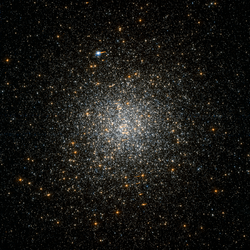astro.wikisort.org - Galaxy
NGC 5286 (also known as Caldwell 84) is a globular cluster of stars located some 35,900[3] light years away in the constellation Centaurus. At this distance, the light from the cluster has undergone reddening from interstellar gas and dust equal to E(B – V) = 0.24 magnitude in the UBV photometric system. The cluster lies 4 arc-minutes north of the naked-eye star M Centauri.[6] It was discovered by Scottish astronomer James Dunlop, active in Australia, and listed in his 1827 catalog.[7]
| NGC 5286 | |
|---|---|
 NGC 5286 imaged by the Hubble Space Telescope | |
| Observation data (J2000 epoch) | |
| Class | V[1] |
| Constellation | Centaurus |
| Right ascension | 13h 46m 26.81s[2] |
| Declination | –51° 22′ 27.3″[2] |
| Distance | 35.9 kly (11.0 kpc)[3] |
| Apparent magnitude (V) | 7.6 |
| Apparent dimensions (V) | 4' |
| Physical characteristics | |
| Mass | 7.13×105[4] M☉ |
| Metallicity | = –1.41[5] dex |
| Estimated age | 12.54 Gyr[5] |
| Other designations | Caldwell 84 |
This cluster is about 29 kly (8.9 kpc) from the Galactic Center and is currently orbiting in the Milky Way halo. It may be associated with the Monoceros Ring—a long tidal stream of stars that could have been formed from a disrupted dwarf galaxy. NGC 5286 may be one of the oldest globular clusters in the galaxy,[6] with an estimated age of 12.54 billion years.[5] It is not perfectly spherical, but has a projected ellipticity of 0.12.[6]
The velocity dispersion of stars at the center of the cluster is (8.1 ± 1.0) km/s. Based upon the motions of stars at the core of this cluster, it may host an intermediate mass black hole with less than 1% of the cluster's mass. The upper limit for the mass estimate of this object is 6,000 times the mass of the Sun.[6]
NGC 5286 is part of the Gaia Sausage, the hypothesised remains of a merged dwarf galaxy.[8]
References
- Shapley, Harlow; Sawyer, Helen B. (August 1927), "A Classification of Globular Clusters", Harvard College Observatory Bulletin, 849 (849): 11–14, Bibcode:1927BHarO.849...11S.
- Goldsbury, Ryan; et al. (December 2010), "The ACS Survey of Galactic Globular Clusters. X. New Determinations of Centers for 65 Clusters", The Astronomical Journal, 140 (6): 1830–1837, arXiv:1008.2755, Bibcode:2010AJ....140.1830G, doi:10.1088/0004-6256/140/6/1830.
- Paust, Nathaniel E. Q.; et al. (February 2010), "The ACS Survey of Galactic Globular Clusters. VIII. Effects of Environment on Globular Cluster Global Mass Functions", The Astronomical Journal, 139 (2): 476–491, Bibcode:2010AJ....139..476P, doi:10.1088/0004-6256/139/2/476, hdl:2152/34371.
- Boyles, J.; et al. (November 2011), "Young Radio Pulsars in Galactic Globular Clusters", The Astrophysical Journal, 742 (1): 51, arXiv:1108.4402, Bibcode:2011ApJ...742...51B, doi:10.1088/0004-637X/742/1/51.
- Forbes, Duncan A.; Bridges, Terry (May 2010), "Accreted versus in situ Milky Way globular clusters", Monthly Notices of the Royal Astronomical Society, 404 (3): 1203–1214, arXiv:1001.4289, Bibcode:2010MNRAS.404.1203F, doi:10.1111/j.1365-2966.2010.16373.x.
- Feldmeier, A.; et al. (June 2013), "Indication for an intermediate-mass black hole in the globular cluster NGC 5286 from kinematics", Astronomy & Astrophysics, 554: A63, arXiv:1304.4176, Bibcode:2013A&A...554A..63F, doi:10.1051/0004-6361/201321168.
- O'Meara, Stephen James (2002), The Caldwell Objects, Cambridge University Press, p. 337, ISBN 9780521827966.
- C., Myeong, G.; W., Evans, N.; V., Belokurov; L., Sanders, J.; E., Koposov, S. (2018). "The Sausage Globular Clusters". The Astrophysical Journal. 863 (2): L28. arXiv:1805.00453. Bibcode:2018ApJ...863L..28M. doi:10.3847/2041-8213/aad7f7.
External links
- Belleville, Michelle, ed. (September 1, 2020). "Caldwell 84". Hubble's Caldwell Catalog. NASA. Retrieved 2020-12-21.
 Media related to NGC 5286 at Wikimedia Commons
Media related to NGC 5286 at Wikimedia Commons- NGC 5286 at Astrosurf
- NGC 5286 on WikiSky: DSS2, SDSS, GALEX, IRAS, Hydrogen α, X-Ray, Astrophoto, Sky Map, Articles and images
На других языках
[de] NGC 5286
NGC 5286, auch bekannt als Caldwell 84, ist ein Kugelsternhaufen, der sich etwa 35.900[3] Lichtjahre entfernt in dem Sternbild Zentaur befindet. Der Kugelsternhaufen liegt 4 Bogenminuten nördlich des mit bloßem Auge sichtbaren Sterns M Centauri und wurde von dem Astronomen James Dunlop von Australien aus mithilfe seines 9-Zoll-Teleskops entdeckt[6] und in seinem Katalog aus dem Jahre 1827 beschrieben.[7][8] Später wurde er unter anderem in den Caldwell und den New General Catalogue aufgenommen.- [en] NGC 5286
[ru] NGC 5286
NGC 5286 (другие обозначения — GCL 26, ESO 220-SC38) — шаровое скопление в созвездии Центавр.Другой контент может иметь иную лицензию. Перед использованием материалов сайта WikiSort.org внимательно изучите правила лицензирования конкретных элементов наполнения сайта.
WikiSort.org - проект по пересортировке и дополнению контента Википедии
